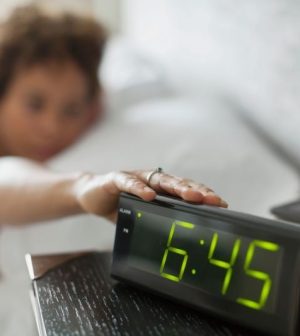- See What Saffron Can Do for Sleep and Heart Health
- 6 Common Mistakes to Avoid Before Your Physical
- Can Sweating Really Help You Beat a Cold?
- Strengthening Your Relationship: Practical Strategies
- Skip Storing This Everyday Product in the Fridge Door
- Green Tea + B3 Pairing May Boost Brain Health
- Navigating Your Midlife Crisis: Embracing New Possibilities
- City Raccoons Showing Signs of Domestication
- Mapping the Exposome: Science Broadens Focus to Environmental Disease Triggers
- One Week Less on Social Media Linked to Better Mental Health
Clocks Forward, Clocks Back: How Does Your Sleep Suffer?

Changing the clocks every spring and fall might seem challenging, but a new study reveals that only one of those changes had a tendency to increase sleep disorders.
The transition from daylight saving time to standard time in the fall — when people gain one hour overnight — was associated with a brief rise in sleep disorders, including difficulty going to sleep or staying asleep.
Surprisingly, that wasn’t seen when switching back to daylight saving time in the spring.
“Previous research has linked the transitions to and from daylight saving time with higher rates of accidents as well as an increased risk of stroke and heart attack,” said study author Dr. Ron Postuma, a neurologist and researcher at McGill University in Montreal. “Future studies are needed that follow individuals over time, including people living in areas with different light exposure and seasonal changes.”
In the study, published online May 3 in Neurology, his team did find a small difference in the amount of sleep people get depending on the season.
Postuma noted that sleep plays an essential role in maintaining good health, mood, cognition, job performance and social activity.
“It is influenced by the circadian rhythm, the internal clock that regulates body processes,” he said in a journal news release. “The good news is that the sleep disruptions we observed following the change to standard time were brief and no longer evident two weeks after the shift.”
For the study, more than 30,000 people were surveyed, ages 45 to 85.
Participants were asked about sleep duration and satisfaction, their ability to fall asleep and remain asleep and about excessive sleepiness during the day.
Questions included, “Over the last month, how often did it take you more than 30 minutes to fall asleep?”
Another was, “Over the last month, how often did you wake in the middle of the night or too early in the morning and found it difficult to fall asleep again?”
People who responded three or more times a week to either of these questions were considered to have sleep problems.
Researchers compared responses of people who completed the questionnaire one week before the transition to standard time to those who completed it one week after.
Those surveyed a week after had a 34% higher risk of sleep dissatisfaction. About 28% said they were dissatisfied with their sleep compared to 23% of those interviewed one week before.
Those who completed the questionnaire after the time change had more than twice the risk for trouble falling asleep as well as excessive sleepiness during waking hours. They also had a 64% higher risk for difficulty staying asleep.
When researchers compared responses from people surveyed a week before and a week after the spring transition to daylight saving time, they found no difference in sleep problems.
They did see a nine-minute decrease in sleep duration one week after the transition.
Participants who completed the questionnaire in summer had the shortest sleep duration, an average 6.76 hours. People who completed the survey in winter reported an average of 6.84 hours of sleep daily.
“As disruptive as these transitions may feel in the short term, there may be few long-term implications of the repeated switch back and forth from daylight saving time to standard time,” Postuma said.
The study only included middle-aged and older adults, so the findings may not apply to younger adults, researchers said.
More information
AARP has more on how daylight saving time affects the body.
SOURCE: Neurology, news release, May 3, 2023
Source: HealthDay
Copyright © 2025 HealthDay. All rights reserved.










